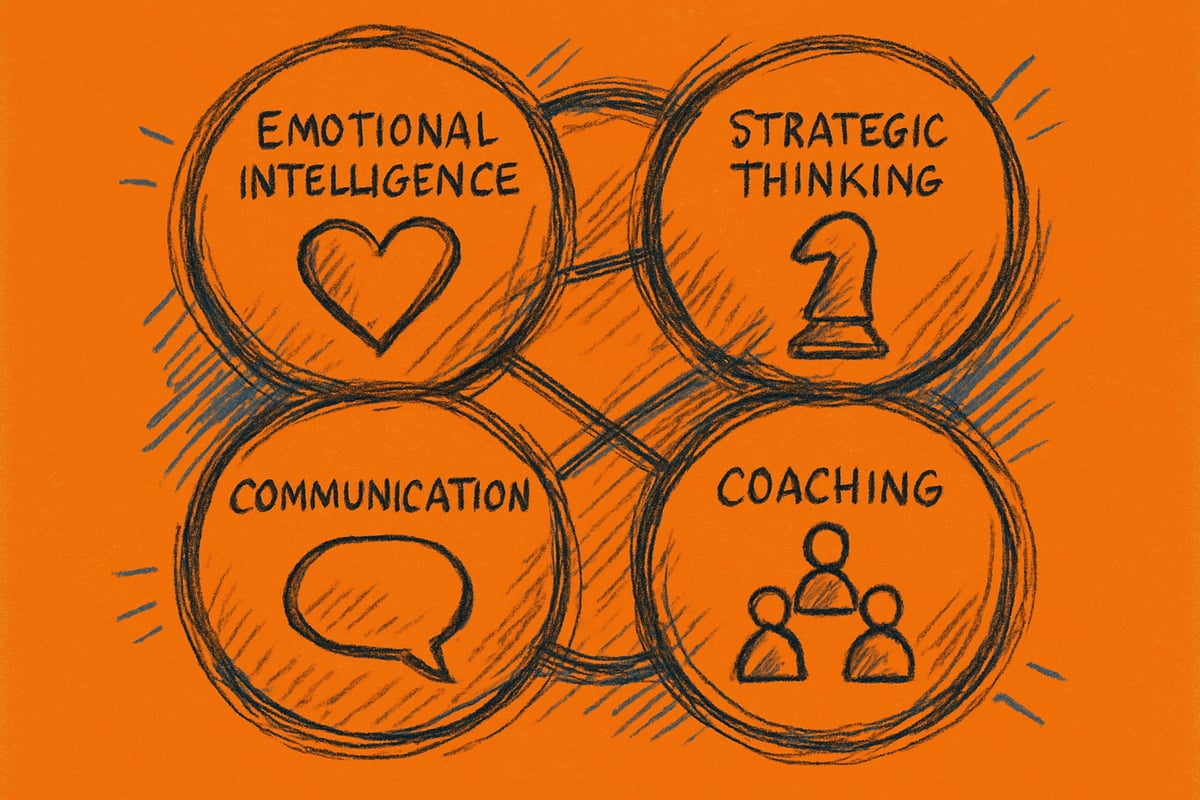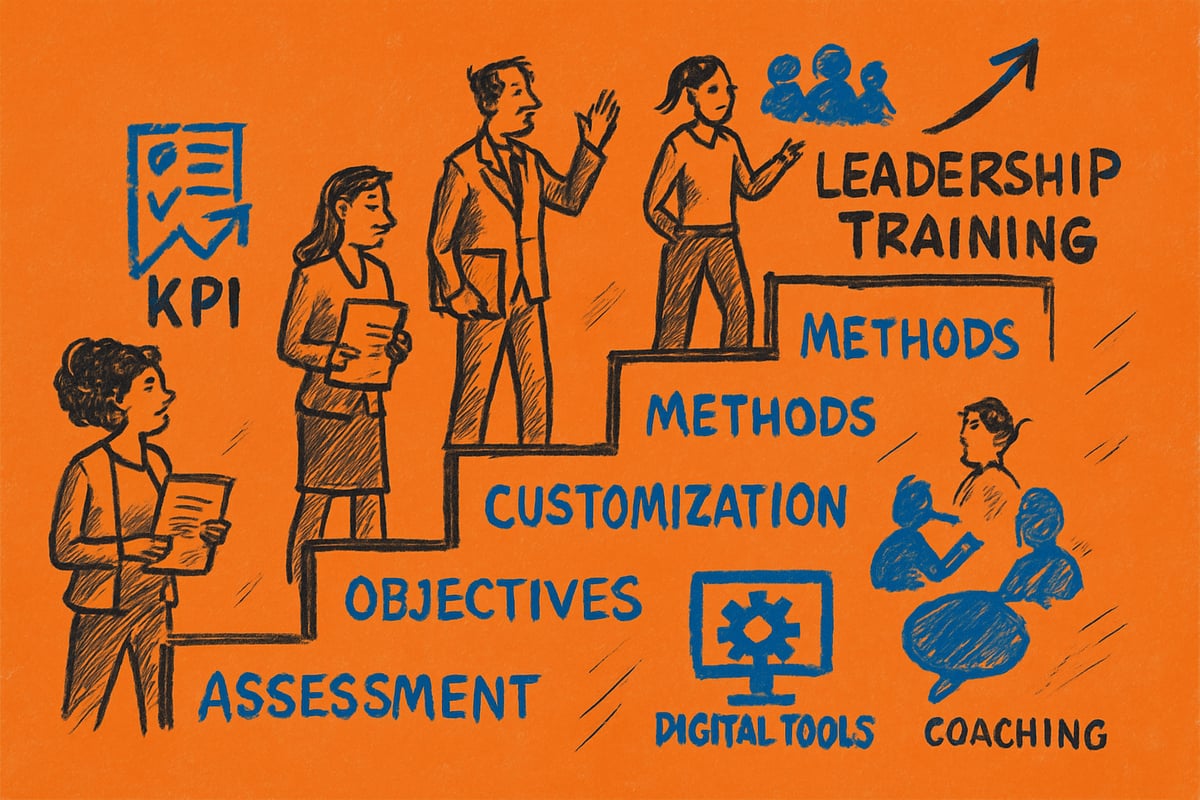The Essential Guide to Leadership Training in 2025
In 2025, the pace of change will demand more from leaders than ever before. Organizations that invest in leadership training will set themselves apart, building resilience and agility in a shifting landscape.
This essential guide dives into the latest trends, core skills, and proven strategies for leadership training in 2025. You will discover why it matters now, what competencies to focus on, and how to measure results. For deeper insights on accountability in leadership, visit Accountability Now.
Explore actionable steps to develop future-ready leaders and transform how your organization leads. Let’s shape the future of leadership together.
Why Leadership Training Is Critical in 2025
In 2025, organizations face a business landscape more volatile and complex than ever before. Hybrid work models, rapid technological advancements, and fierce global competition are creating new demands for leaders at every level. As a result, leadership training is not just a development tool, it is a business necessity.
Companies are grappling with constant change. The shift to hybrid and remote work has redefined team dynamics and communication. Digital transformation is accelerating, requiring leaders to adopt new technologies quickly. Multigenerational teams bring diverse perspectives but also unique management challenges.
Recent research shows that 77% of organizations now consider leadership gaps a top concern. This alarming statistic highlights a critical risk: without effective leadership training, businesses may struggle to adapt, innovate, and retain top talent. You can review more detailed data and insights in the Leadership Training Statistics 2025 report.
The impact of leadership training reaches every corner of an organization. Strong leaders drive higher employee engagement, foster loyalty, and boost overall productivity. In contrast, poor leadership leads to increased turnover, low morale, and missed business opportunities. Replacing a single employee can cost up to twice their annual salary, making leadership skills a direct factor in controlling costs.
New leadership challenges are emerging daily. Managing remote or hybrid teams requires trust and clear digital communication. Navigating digital transformation means leaders must be comfortable with new tools and data-driven decision-making. Additionally, today’s leaders must bridge generational gaps, ensuring that all team members feel valued and included.
Consider the financial impact. Companies that invest in leadership training see up to 2.4 times higher revenue growth compared to those that do not, according to Dale Carnegie research. This substantial difference underlines the return on investment for organizations that make leadership development a priority.
Below is a table summarizing the core impacts of leadership training:
| Impact Area | With Leadership Training | Without Leadership Training |
|---|---|---|
| Employee Engagement | High | Low |
| Retention | Improved | High Turnover |
| Productivity | Increased | Stagnant or Declining |
| Innovation | Accelerated | Missed Opportunities |
| Revenue Growth | Up to 2.4x higher | Slower or Negative |
Leadership training offers a competitive edge that goes beyond the basics. It is a catalyst for innovation, adaptability, and resilience in uncertain times. Leaders who are equipped to coach, communicate, and inspire can unlock the full potential of their teams.
The strategic importance of leadership training is clear. In a world of constant disruption, it is no longer optional. Organizations that treat leadership development as a core business strategy will be better prepared to navigate change, outperform competitors, and secure long-term success. For more resources on accountability and leadership, you may wish to visit accountabilitynow.net.

Core Leadership Competencies for 2025
Effective leadership training in 2025 requires a new set of core competencies. As organizations adapt to hybrid work, digital transformation, and global shifts, leaders must develop skills that go beyond traditional management. These four key areas define the foundation of impactful leadership in the modern era.

Emotional Intelligence and Self-Awareness
In 2025, emotional intelligence is a non-negotiable element of leadership training. Leaders who understand and manage their emotions, show empathy, and actively listen can build trust and foster collaboration across teams. This competency directly influences how leaders respond to stress, navigate conflict, and support diverse workforces.
Research shows that 90% of top performers possess high emotional intelligence, making it a strong predictor of leadership success. Courses from Dale Carnegie and similar organizations focus on self-awareness and emotional regulation, helping leaders recognize their strengths and blind spots. Tactics such as mindfulness exercises, reflective journaling, and 360-degree feedback are proven methods to enhance emotional intelligence.
The Leadership Development Study 2025 highlights that organizations prioritizing emotional intelligence in leadership training experience higher engagement and lower turnover. Leaders who invest in self-awareness create more resilient and adaptable teams.
Strategic Thinking and Decision-Making
Strategic thinking is essential for navigating the complexity of today’s business environment. Leadership training in 2025 must equip leaders to analyze data, anticipate market trends, and make informed decisions that align with both short-term goals and long-term vision.
Scenario planning, critical thinking workshops, and regular strategy sessions help leaders sharpen their decision-making abilities. AMA’s leadership seminars, for example, place a strong emphasis on developing strategic planning skills. Leaders are encouraged to balance agility with discipline, adapting quickly to new information while remaining focused on organizational objectives.
Data-driven decision-making is now a core expectation. Leaders who excel in this area use analytics to guide their choices and encourage their teams to embrace innovation. Strategic thinking ensures that leadership training is not just about theory but about practical application in real-world scenarios.
Communication and Influence
The ability to communicate clearly and influence others is a cornerstone of effective leadership training. In 2025, leaders must build trust through authentic, transparent communication—especially as teams become more cross-functional and geographically dispersed.
Storytelling, constructive feedback, and assertive communication techniques are vital tools for leaders. Digital fluency is equally important, with hybrid environments demanding proficiency in virtual presentations and remote collaboration. Dale Carnegie’s high-impact presentation courses exemplify how leaders can engage audiences and drive results.
Leaders need to lead with influence rather than authority. This shift encourages collaboration and empowers team members to take ownership of their work. Leadership training programs should include opportunities for leaders to practice and refine these skills, ensuring they can inspire action across all levels of the organization.
Coaching, Development, and Team Engagement
Modern leadership training recognizes the importance of moving from a directive approach to one centered on coaching and development. Leaders who act as coaches empower their teams, foster inclusion, and create psychological safety, all of which are essential for high performance.
Manager-as-coach programs, team facilitation training, and regular feedback sessions help leaders support ongoing growth. Engaged teams are proven to be 21% more profitable, according to Gallup. Leadership training should encourage leaders to prioritize engagement through recognition, open dialogue, and continuous development.
Effective leaders know that investing in others multiplies results. By embracing the role of coach, leaders can unlock their teams’ potential and drive sustained organizational success. For additional resources on accountability and leadership, see Accountability Now.
The Most Effective Leadership Training Methods in 2025
Adapting to the demands of 2025, organizations must rethink their approach to leadership training. The most successful programs blend innovation with practicality, ensuring leaders are prepared for constant change. Let us explore the most impactful methods shaping leadership development this year.

Blended Learning: In-Person, Online, and On-Demand
Blended learning is now the foundation of effective leadership training. By combining live workshops, virtual classrooms, and self-paced modules, organizations offer flexibility for diverse learning styles and schedules. This approach helps participants apply new skills in real time, whether they are in the office or remote.
A recent survey found that 65 percent of organizations are leveraging blended learning for leadership development. This method ensures training is accessible to all, regardless of location or role. For instance, both AMA and Dale Carnegie provide hybrid offerings that mix live interaction with digital content, maximizing engagement.
For a deeper look at how digital tools and blended strategies are transforming leadership training, visit Leadership Training Trends 2025. These insights reveal why blended learning is crucial for building future-ready leaders.
Experiential Learning and Real-World Application
Experiential learning is all about learning by doing. Action learning projects, simulations, and role-playing exercises immerse leaders in real-world challenges. This hands-on approach is proven to boost retention and drive meaningful behavior change, making it a core element of leadership training in 2025.
Leaders might participate in live coaching during meetings or tackle project-based assignments that mirror their actual responsibilities. These methods allow immediate application, bridging the gap between theory and practice. As a result, organizations see stronger leadership pipelines and more agile teams.
Emphasizing real-world application within leadership training not only accelerates skill development but also fosters accountability, as highlighted by resources like Accountability Now. Embedding experiential learning into daily workflows ensures leaders are always adapting and growing.
Peer Learning, Mentoring, and Coaching
Peer learning is gaining traction as a powerful component of leadership training. Through cohorts, mastermind groups, and leadership circles, participants learn from each other’s experiences. Structured mentoring and executive coaching further reinforce skills and provide ongoing support.
Many organizations rely on 360-degree feedback to help leaders identify blind spots and growth opportunities. In fact, 71 percent of Fortune 500 companies use mentoring programs to strengthen their leadership pipelines. Peer learning not only improves accountability but also builds lasting professional networks.
Leadership training programs that incorporate peer and coaching elements create a culture of continuous improvement. These relationships help leaders stay motivated and engaged while driving organizational success.
Digital Tools and Leadership Assessments
Technology is transforming leadership training in 2025. Online assessments help identify individual strengths and gaps, allowing programs to be tailored for maximum impact. AI-powered platforms create personalized learning paths, track progress, and offer real-time feedback.
Digital dashboards and KPI scorecards make it easy to measure the effectiveness of training. For example, leadership style assessments and feedback platforms provide actionable insights for ongoing development. Organizations can now deliver targeted training at scale, supporting leaders wherever they are.
By integrating digital tools into leadership training, companies ensure their programs remain agile and data-driven. This approach leads to stronger leaders who are ready to face the challenges of tomorrow.
Building a Future-Ready Leadership Training Program: Step-by-Step
Building a future-ready leadership training program is essential for organizations that want to thrive in 2025. Today’s workplace is complex, requiring leaders who are adaptable, strategic, and people-focused. By following a structured, step-by-step process, you can ensure your leadership training initiatives are aligned with business goals and drive measurable results.

Step 1: Assess Organizational Needs and Leadership Gaps
The first step in effective leadership training is a thorough assessment of your organization’s current state. Begin by conducting needs assessments and skills inventories. Use tools like 360-degree feedback, employee surveys, and interviews with key stakeholders to gather data.
Identify where your leadership bench is strong and where gaps exist. Are there critical skills missing for future growth? Is your current team equipped to manage remote or cross-generational teams? Align these insights with organizational goals to set a clear direction for your leadership training program.
By pinpointing gaps early, you lay the groundwork for a targeted approach. This ensures your investment in leadership training directly addresses your company’s most pressing challenges and opportunities.
Step 2: Define Clear Learning Objectives and KPIs
Once needs are identified, set specific learning objectives for your leadership training program. These objectives should be measurable and directly linked to business outcomes. For example, you might aim to boost employee engagement scores by 15 percent or cut voluntary turnover by 10 percent within a year.
Develop a set of key performance indicators (KPIs) to track progress. Common KPIs include:
- Pre- and post-training assessment scores
- Promotion rates among program graduates
- Retention rates in critical roles
- Increases in team productivity
Clear objectives and KPIs keep leadership training focused and accountable. They also provide benchmarks to demonstrate the program’s value to stakeholders and drive continuous improvement.
Step 3: Customize Content for Roles, Levels, and Generations
Leadership training is not a one-size-fits-all process. Tailor your content to the needs of different roles, experience levels, and generations. First-time managers require foundational skills, while senior leaders benefit from strategic and change management content.
Consider the generational mix within your teams. Millennials and Gen Z may value digital-first learning and frequent feedback, while more experienced leaders might prefer in-depth workshops and peer discussions.
Create specialized tracks or modules for each group. This targeted approach increases engagement and ensures every participant receives relevant, actionable development. Effective leadership training recognizes and adapts to the diversity within your organization.
Step 4: Select and Integrate the Right Training Methods
Choosing the right mix of delivery methods is critical for successful leadership training. Blend live workshops, virtual classrooms, e-learning modules, and peer forums to meet diverse learning preferences and schedules.
Ensure accessibility for remote, hybrid, and global teams. Use digital platforms to deliver content anytime, anywhere. Incorporate real-world projects, coaching sessions, and role-playing exercises for practical skill development.
A blended, flexible approach maximizes participation and knowledge retention. When selecting methods, always tie them back to your program’s objectives and the unique needs identified in earlier steps.
Step 5: Implement, Support, and Reinforce Learning
Implementation is about more than scheduling sessions. Provide resources, ongoing coaching, and opportunities for leaders to apply new skills in daily work. Embed leadership training into regular meetings, performance reviews, and team projects.
Support doesn’t end when training concludes. Offer follow-up coaching, peer learning circles, and access to expert guidance. For organizations seeking external expertise, the Top business coaches directory connects you with professionals who can reinforce and sustain leadership development.
Reinforcement ensures learning sticks and translates into behavior change. Building accountability and a culture of continuous improvement transforms leadership training from a one-time event into a strategic advantage. For more on building accountability into your leadership approach, visit Accountability Now.
Measuring the ROI of Leadership Training
Understanding the return on investment (ROI) of leadership training is essential for organizations aiming to maximize development budgets and drive lasting business impact. Clear definitions of success are foundational. What does effective leadership look like for your company? Start by outlining key performance indicators (KPIs) that align leadership growth with strategic business outcomes.
ROI measurement for leadership training goes beyond intuition. Organizations should track specific metrics that reflect both immediate and long-term value. Common indicators include:
- Employee engagement scores
- Retention and turnover rates
- Productivity and performance metrics
- Financial outcomes, such as revenue growth
A blend of tools helps capture these metrics. Pre- and post-training assessments provide a baseline for skill growth. Feedback surveys and 360-degree reviews reveal shifts in leadership behavior. Digital dashboards and performance management systems ensure data is accessible and actionable. Many companies also partner with external coaches for objective evaluation, such as those found through Business coaching in the US.
| Metric | Measurement Tool | Business Impact |
|---|---|---|
| Engagement | Surveys, pulse checks | Increased productivity |
| Retention | HR analytics | Reduced hiring costs |
| Productivity | Performance reviews | Higher output |
| Financial Performance | Revenue/profit tracking | Tangible ROI |
Real-world results underscore the value of leadership training. Organizations that invest in targeted programs report up to 34% higher retention, according to the American Management Association. When leadership training is directly connected to culture and strategic initiatives, the gains are even greater. Companies often see improved innovation, stronger team morale, and measurable growth in business performance.
Measuring soft skills development and long-term impact can be challenging. Unlike technical training, the influence of leadership training may unfold over months or even years. To address this, organizations should gather qualitative feedback, track behavior change, and monitor overall business trends. For example, a large firm implemented an ongoing leadership training initiative and saw a sustained rise in engagement and profitability, confirming the tangible benefits.
Continuous measurement and adjustment are critical for sustained ROI. Leadership training is not a one-time event but an evolving process. Regularly revisit KPIs, update training content, and reinforce learning through coaching and accountability structures. For further insights on building accountability into leadership development, refer to resources such as Accountability Now.
Ultimately, the most effective leadership training programs are those that connect learning outcomes with business priorities, leverage robust measurement tools, and foster a culture of ongoing growth. By treating ROI analysis as a strategic investment, organizations ensure their leadership pipeline remains strong and future-ready.
Trends and Innovations Shaping Leadership Training in 2025
As organizations look ahead, leadership training is transforming rapidly to meet shifting workforce expectations, new technology, and global demands. In 2025, the most effective programs are shaped by trends that prioritize inclusivity, digital innovation, and ongoing development. Understanding these trends helps organizations build resilient leaders ready for tomorrow’s challenges.
Emphasis on Diversity, Equity, Inclusion & Belonging (DEI&B)
Leadership training in 2025 places DEI&B at its core. Organizations recognize that inclusive leadership drives better business outcomes and stronger teams. Research shows that companies with diverse leadership outperform peers by 33 percent, making DEI&B not just an ethical priority but a strategic advantage.
Modern leadership training programs now weave DEI&B principles into every aspect of the curriculum. This includes training leaders to recognize bias, foster psychological safety, and create cultures where every voice is valued. Programs such as Leadership Trends 2025 highlight the growing demand for leaders who champion equity and belonging in a global context.
Leaders who excel in DEI&B are more effective at engaging teams and driving innovation. By embedding these values into leadership training, organizations prepare leaders to meet complex challenges and inspire high-performing, inclusive teams.
AI and Technology in Leadership Development
AI and digital platforms are revolutionizing leadership training, enabling personalized learning at scale. In 2025, artificial intelligence is used to assess leader strengths, recommend targeted content, and deliver real-time feedback. Virtual reality simulations allow leaders to practice skills in immersive, risk-free environments.
AI-powered coaching tools adapt to each learner’s pace, ensuring that leadership training is both efficient and engaging. Digital dashboards provide leaders and organizations with actionable insights, tracking progress and identifying areas for growth.
The integration of technology makes leadership training more accessible for distributed teams. It also ensures that learning is continuous, data-driven, and aligned with business objectives. As these innovations evolve, organizations that harness technology gain a significant edge in developing agile, future-ready leaders.
Leadership for Hybrid and Remote Teams
The rise of hybrid and remote work has redefined what effective leadership training looks like. Leading distributed teams requires new skills, such as building trust virtually, fostering engagement across time zones, and maintaining accountability without physical presence.
Leadership training in 2025 includes modules focused on digital communication, remote team management, and virtual collaboration. Leaders learn to use technology to connect authentically with their teams, set clear expectations, and support well-being from afar.
Case studies show that organizations investing in leadership training for hybrid environments see higher retention and productivity. By preparing leaders for the realities of remote work, companies can create cohesive teams that thrive regardless of location. For additional insights on holding leaders accountable in virtual settings, resources like Accountability Now offer practical frameworks.
Continuous, Lifelong Leadership Development
Gone are the days when leadership training was a one-time event. In 2025, development is seen as a lifelong journey, supported by microlearning, mobile apps, and on-demand resources. Leaders are encouraged to pursue continuous growth and adapt to changing business needs.
Subscription-based leadership training programs provide fresh content and ongoing support. Peer learning, mentorship, and coaching remain central, helping leaders apply new skills in real time. Platforms like Life coaching and leadership skills offer tailored coaching and development paths, ensuring leaders receive personalized guidance at every stage.
By fostering a culture of lifelong learning, organizations ensure that leadership skills stay relevant and impactful. This approach not only boosts individual performance but also drives long-term organizational success.
Common Pitfalls and How to Overcome Them
Leadership training is a powerful driver of growth, but many organizations stumble by repeating preventable mistakes. Addressing these common pitfalls is essential for turning leadership training into a true engine for engagement, innovation, and performance.
Treating Leadership Training as a One-Time Event
One of the most persistent mistakes is viewing leadership training as a single, isolated event. Many organizations invest heavily in workshops or seminars but fail to provide ongoing opportunities for growth. Research shows that skills gained during one-off training sessions fade quickly without reinforcement.
Continuous learning is essential for lasting impact. Leaders must have regular access to new knowledge, practice opportunities, and real-world feedback. Organizations that implement ongoing leadership training see sustained improvements in engagement and adaptability. By creating a culture of learning, businesses ensure their leaders remain prepared for evolving challenges.
Focusing on Theory Over Practice
Another common pitfall is relying too heavily on theory and neglecting hands-on experiences. While foundational models and frameworks are valuable, leadership training that lacks practical application often fails to create real behavioral change.
Effective programs balance conceptual learning with real-world exercises—such as simulations, role-playing, and project-based assignments. These methods allow leaders to apply new skills directly to their work context. For instance, organizations that incorporate live coaching or peer learning circles see greater skill retention and more confident leaders. Prioritizing practice over theory transforms knowledge into measurable results.
Lack of Follow-Up and Reinforcement
Without structured follow-up and reinforcement, even the best leadership training can lose its effectiveness. Studies indicate that regular reinforcement increases training success rates by up to 60 percent. Leaders benefit from ongoing coaching, feedback, and accountability systems to solidify new behaviors.
Action plans, peer support groups, and digital check-ins all contribute to sustained development. Leveraging resources like Accountability Now can help organizations build robust accountability frameworks, ensuring leadership training delivers lasting change. Consistent support encourages leaders to apply their learning and adapt quickly to new demands.
Failure to Align Training with Strategy and Culture
A final major pitfall is failing to align leadership training with the organization’s strategic goals and culture. Generic programs rarely address the unique needs of diverse teams or evolving business priorities. When training is disconnected from real objectives, it risks being ignored or forgotten.
To overcome this, organizations should tailor leadership training to fit their vision, values, and workforce dynamics. Involving leaders in program design, using culture-specific case studies, and tying outcomes to business metrics ensures relevance. Investing in alignment builds organizational resilience and prepares leaders to drive meaningful change.
| Pitfall | Solution |
|---|---|
| One-Time Training Event | Continuous, ongoing learning opportunities |
| Too Much Theory, Not Enough Practice | Real-world application and hands-on learning |
| No Follow-Up or Reinforcement | Coaching, accountability, regular check-ins |
| Misalignment with Strategy and Culture | Tailored programs linked to business goals |
By recognizing and addressing these common pitfalls, organizations can unlock the full potential of leadership training and foster a culture of growth, accountability, and adaptability.




Leave a Reply
Want to join the discussion?Feel free to contribute!